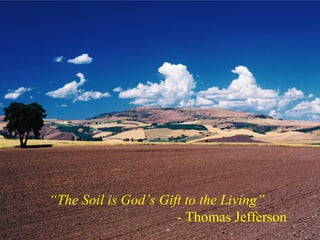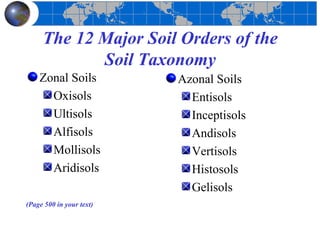Soils
- 1. “The Soil is God’s Gift to the Living” - Thomas Jefferson
- 2. Soil Formation Factors and Management Natural Factors ClORPT Climate Organic Material Relief Parent Material Time The Human Factor
- 3. Soil Sampling and Mapping Units Figure 15.1
- 4. A nearly O mature profile…. A 10,000 years in E the making B Figure 15.2
- 5. Soil Properties Color  An indication of material in the soil Texture  An indication of the amount of weathering Structure   An indication of its chemical and physical properties of the parent material Consistence   An indication of its structural integrity Porosity   Related to texture – an indication of grain size Moisture An indication of the environment it is in
- 6. Soil Texture Triangle Figure 15.3
- 7. Types of Soil Structure Figure 15.4
- 8. Soil Colloids and Cation Exchange Capacity Figure 15.5
- 9. Soil Moisture and Cation Exchange Capacity
- 10. pH Scale and Soils Figure 15.6
- 11. Soil Classification Soil Taxonomy Classification of soils based on observed properties Diagnostic Soil Horizons Usually the O, A, E, B horizons
- 12. The 12 Major Soil Orders of the Soil Taxonomy Zonal Soils Azonal Soils Oxisols Entisols Ultisols Inceptisols Alfisols Andisols Mollisols Vertisols Aridisols Histosols Gelisols (Page 500 in your text)
- 14. The Factors Forming the Koeppen System Figure 6.5
- 15. Pedogenic Regimes Laterization Movement of water freely through soils Salinization Laterization Arid environments, water evaporates leaving salts to build up in soils Gleization Calcification Moisture Movement of calcium through the soil through capillary water Podzolization Podzolization Slower movement of water through soils allowing for build-up of strongly zonal Calcification soils with water-logged lower horizons Gleization Salinization In cold environments, slow decomposition of organic material Temperature allowing it to build up over time.
- 16. Laterization Heavy Rainfall A – very little minerals left Hot temperatures allow decomposers and plant roots to remove organic material quickly B – only clay (sesquioxides) remain Orange to red color comes from rusting of iron Nearly all minerals are leached out – even sands and silts are washed away leaving only thick clay layer
- 17. Oxisols “Terra Rosa” Figures 15.9, 15.11
- 18. Ultisols Figure 15.19
- 19. Podzolization Process Figure 15.20
- 20. Alfisols Figure 15.18
- 21. Spodosols Figure 15.20
- 22. Calcification in soil Figure 15.17
- 23. Mollisols Figures 15.14, 15.15
- 24. Mollisols Figure 15.16
- 25. Aridisols Figures 15.12, 15.13
- 26. Vertisols – an azonal soil Figures 15.24, 15.25
- 27. Histosols – another azonal soil Figure 15.26




























